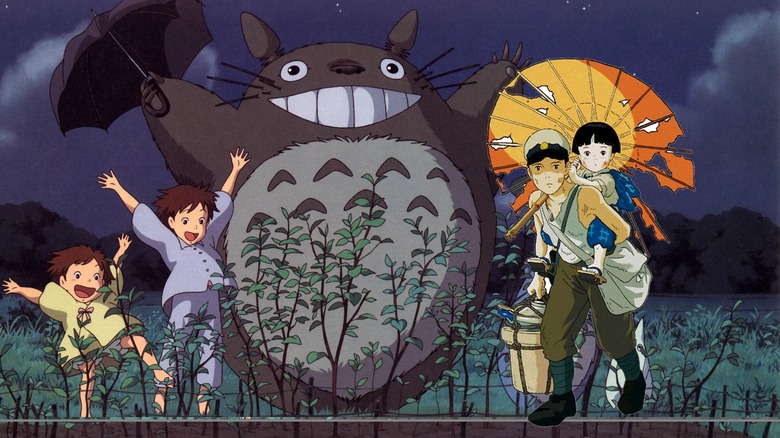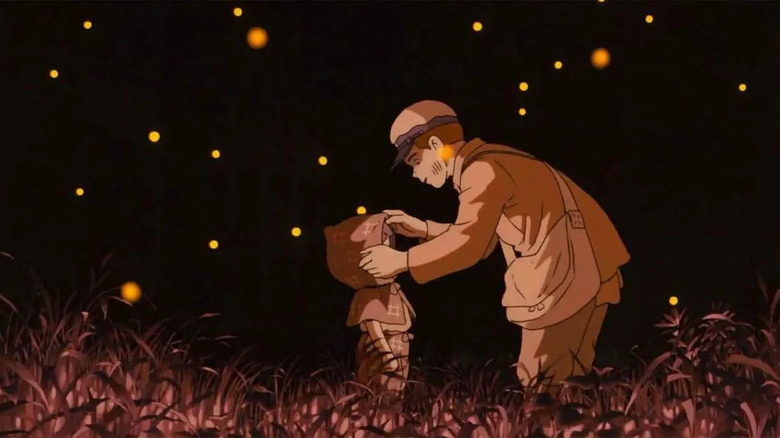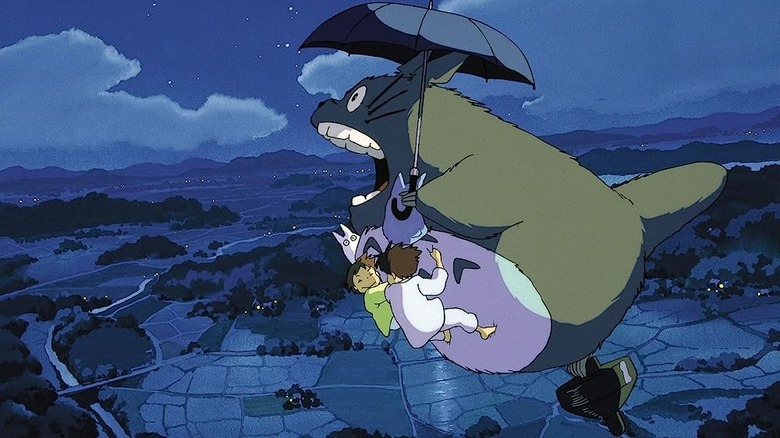That Time Studio Ghibli Traumatized A Generation With Their Own Barbenheimer
"Barbenheimer" is the cinematic event of the summer. Greta Gerwig's "Barbie" and Christopher Nolan's "Oppenheimer" are highly anticipated films by two acclaimed directors that could not be more different. One is a deep, subversive exploration of an iconic figure in American history, whose complicated legacy is filled with controversy. The other is a movie about J. Robert Oppenheimer.
What makes this particular case of counterprogramming so unique and fun is that, beyond the tone of both movies, their subject matters themselves are polar opposites. "Oppenheimer" deals with one of the darkest chapters in human history and recreates a nuclear explosion, and "Barbie," well, is a pink-colored party with Ryan Gosling continuing to prove he belongs in comedies. That's what separates this from other competing summer blockbusters like "The Dark Knight" and "Mamma Mia," but it is not the first time a gripping drama about WWII is released on the same day as a fun, energetic movie about larger-than-life characters going on a fantastic adventure (that nevertheless hides dark undertones).
You see, 35 years ago, Studio Ghibli released an epic double feature, with one of their most iconic and popular movies — which also gave them a mascot — released simultaneously with a movie widely considered to be one of the saddest animated movies ever made. Before there was Barbenheimer, audiences got a "My Neighbor Totoro" and "Grave of the Fireflies" double feature, aka My Neighbor the Fireflies, or Grave of the Totoro.
'Why must fireflies die so young?'
After 1986's "Castle in the Sky" marked the official launch of Studio Ghibli, co-founders Isao Takahata and Hayao Miyazaki got to work on their own next projects. Miyazaki would go on to tell a tale in post-war Japan about two girls living in the countryside hanging out with nature spirits as their mother lies sick, beginning a career of whimsical movies that nevertheless tackled emotionally complex subjects. Meanwhile, Takahata began a career of melancholic films about life in Japan, and about growing up, starting with this harrowing tale of two kids trying to survive unspeakable horrors in the last days of WWII.
Tonally, both movies could not be very different — "My Neighbor Totoro" is a story fit for a Muppet musical, while "Grave of the Fireflies" haunts your dreams forever — and they were not only released on the same day in Japanese cinemas, they were also billed as a double feature. Indeed, on April 16, 1988, Japanese audiences could see little Mei wake up the gentle giant Totoro while Joe Hisaishi's iconic song plays, then follow that up with a movie about two orphan siblings desperately try not to die in the war.
Though neither film was an instant hit, it was the merchandise for "My Neighbor Totoro," particularly stuffed animals of the Catbus and the titular Totoro that made the film a huge success and made the studio viable enough to continue making films to this day — no wonder Totoro became the studio's mascot.
A wonderful journey will begin
The order of release for this double feature can also give us a hint as to the right order to experience "Barbenheimer." As the story goes, different theaters released the two films in different order, and the theaters that screened "Totoro" first would see audiences so happy and satisfied with the film they did not feel the need to move on to the sad "Grave of the Fireflies." So, in the years since, the general consensus became that you first see the harrowing war film, then dry away the tears with the happier tale of Totoro. Turns out, Tom Cruise was right.
No matter the order, however, both movies are excellent, and they have more in common than first meets the eye. Though "Fireflies" is definitely more emotionally devastating, "Totoro" isn't exactly a walk in the park. The brilliance of Miyazaki's film is that the whimsical story with the titular woodland spirit serves as a distraction for the two young protagonists from the traumas of life. Both movies deal with children growing up amidst traumatic experiences, and both are set within realistic versions of Japan grounded in history.
Even 35 years later, the parallels between "Grave of the Fireflies" and "My Neighbor Totoro," and the way they were released, continue to fascinate audiences. Will we look back at Barbenheimer in 35 years and find them thematically similar? Time will tell.


